Should parents ever worry about Minecraft?
- Published
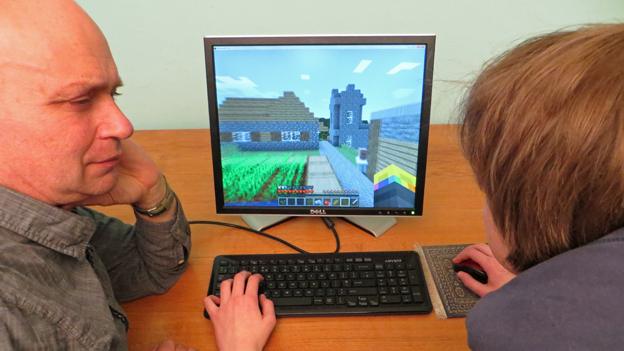
Jolyon Jenkins and his son Joe
In the space of a few years, the computer game Minecraft has come to dominate the spare hours of millions of children, and has even entered the classroom. But is this an entirely good thing, asks Jolyon Jenkins.
If I want to irritate my 13-year-old son, Joe, I refer to Minecraft as "digital Lego". He grew out of Lego a long time ago.
But that's what Minecraft is - a computer game in which you build things using cubic blocks. But it's Lego on steroids. You never run out of blocks and they never topple over. You can walk among your own creations, and play online with other people who are in the same world.
Sometimes, monsters come out after dark to try to kill you, which is never pleasant, but compared with games like Grand Theft Auto and Call of Duty, Minecraft is innocent, peaceful, and pretty wholesome.
So why does it drive so many parents to distraction?
"It's all consuming," says Gabrielle Wacker, of her 11-year-old son Arthur. "It's become a way of life. He would be on it before school given the chance. I've had to hide the device in the morning."
Her biggest worry, she says, is that it reduces his interest in the real world. "He doesn't do any clubs any more. At weekends, one of the first things he says when he gets up in the morning is, 'We're not going anywhere, are we?' because clearly he wants to be at home where he has got access to the devices."
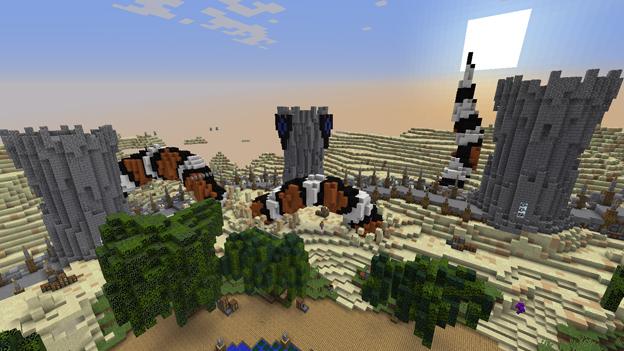
A castle encountered on Joe's adventures in Minecraft
Parenting websites are full of such stories. If not actually playing Minecraft, parents report that their children watch videos of other people playing it.
The statistics are astounding - one group of Minecraft gamers, Yogscast, based in Bristol, is watched for 37 million minutes every day, and they are not the biggest.
The stars of Minecraft, like "Stampy Longnose" are to this generation of children what John Noakes was to mine, except Blue Peter was only on twice a week, whereas Stampy is viewable all day, every day, a permanent uninvited guest in some households.

Brief history of Minecraft
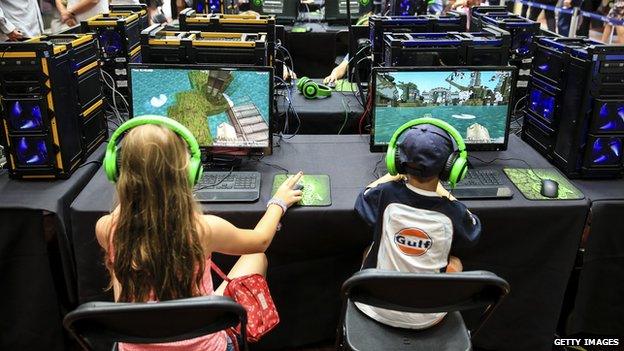
Developed in Sweden by Markus Persson and his company Mojang - officially released in 2011
Company has sold 33 million copies of game in different formats
Bought by Microsoft for $2.5bn (£1.5bn) in September 2014

I hesitate to use the word "addicted", but for some children it seems to fit.
Dr Richard Graham, a consultant child and adolescent psychiatrist who runs a technology addiction unit at the private Nightingale Hospital in London, sees children with a serious Minecraft habit. He talks about the game's "hyper-reality" which he says makes the external world "slower, paler, less stimulating".
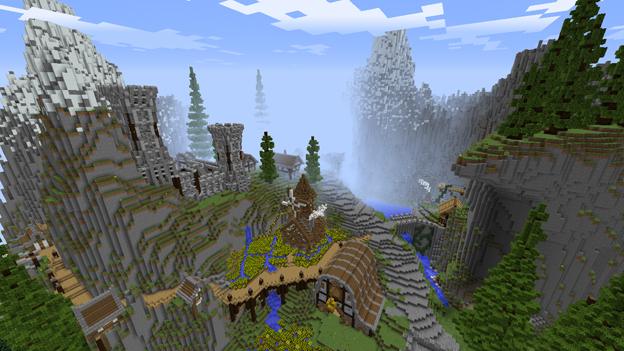
A sweeping valley featuring a castle
My son Joe has his own server, where 20 or so like-minded friends have been creating their own world for the last couple of years. Most of them are in America, and he has never met any of them. Their creations are impressive, but still - is it right for kids to be shunning the real world for this virtual, low-res, blocky universe?
The moves in this argument are as well-rehearsed as a 17th Century gavotte. Minecraft's champions say that it's very creative and that I should just look at the things kids are making on it.
I concede the point but say that it's two-dimensional, and that children should be exercising more than their mouse fingers. The other side asks why it's any worse than reading for hours at a time.
Because, I say, reading allows you to imaginatively inhabit other minds. The opposition implies that this is just the latest moral panic, and that Stone Age elders probably thought the world was going to the dogs when people stopped just staring at the fire and started telling each other stories.
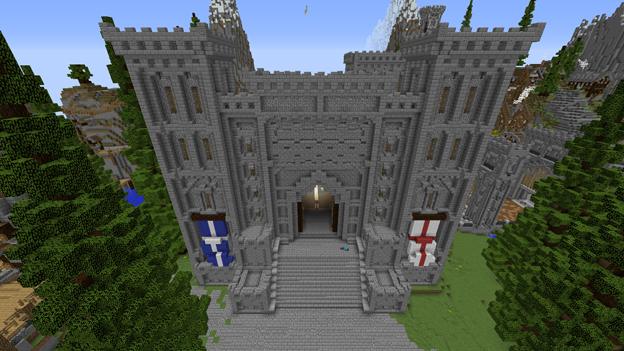
A particularly imposing entrance to a castle
But then there's the "griefing". Because Minecraft is a world with private property but no police force, children are, at least on public servers, in a world that philosopher Thomas Hobbes would have recognised - a state of nature where all are at war with all.
"Griefers" are people who deliberately make trouble, destroy property, and then sometimes post videos of their exploits to amuse everyone.
Even Joe, on his well-ordered server, has had his property stolen by a Russian member. He doesn't know where his stuff went, but suspects it was disposed of in molten lava. When parents think of online bullying, they probably don't think of hard-earned virtual property being trashed, or their children being digitally mugged.

Joe's nine tips to bluff your way in Minecraft:
1. Diamond is the best material for pickaxes because it breaks blocks the fastest and lasts the longest.
2. Players can tame wild wolves by feeding them a few bones, and ocelots with fish.
3. Throwing an Ender Pearl like a ball allows you to teleport to where it lands.
4. With redstone, you can create complex mechanisms. Some people have even recreated computers.
5. The only blocks in the game which are affected by gravity are sand, gravel, and anvils.
6. Creepers are green creatures which will sneak up behind you and try to blow you up. Skeletons try to shoot you with bows.
7. Cows and sheep can be bred by feeding them wheat, pigs with carrots and chickens with seeds.
8. You can play music to nearby players with a music disc, which are created when a skeleton shoots a creeper.
9. A trapped chest will give off a redstone signal when opened, meaning you can create all sorts of traps to fool your friends.

It was in a bid to deal with griefers that Amanda Osborne set up her own server where her son Callum could play in relative safety. Callum, aged nine, is autistic, and finds it easier to interact with people in the Minecraft world than in the real one.
Now, children with autistic spectrum disorders from around the world are logging on to Amanda's server and making amazing, inspiring creations that impressed even Joe when we paid an online visit.
For some autistic children who have trouble with complex social interactions, Minecraft is clearly a good fit with its lack of intricate social cues and simple environment. But for many parents, the absence of that complexity, in a world where their children spend so much time, might be a reason to be wary.
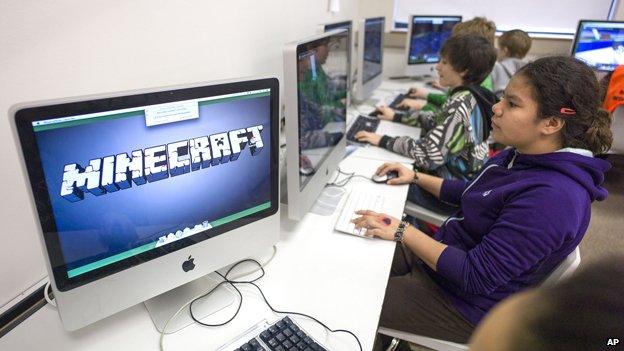
Schools - such as this one in Juneau, Alaska - have started introducing Minecraft into lessons
But Minecraft is unstoppable. You might think that at least school provides a few hours of Minecraft-free time a day, but the game is coming to classrooms, as education experts enthuse about its ability to engage and capture the imagination of children who are hard to reach through traditional teaching methods. Even the British Museum is getting volunteers to recreate the building and its exhibits in Minecraft.
Worst of all, Lego has brought out its own Minecraft set. What this means for the next generation of engineers brought up in a world where nothing ever falls over, I dare not imagine.

More from the Magazine

The community of people involved with the game numbers in the tens of millions. Many of those fans are children; among whom it is almost a religion.
Why Minecraft is more than just another video game (September 2013)

Jolyon Jenkins presents Minecraft: More Than A Game on BBC Radio 4 at 11:00 BST, 30 March 2015 - listen on BBC iPlayer
Subscribe to the BBC News Magazine's email newsletter to get articles sent to your inbox.